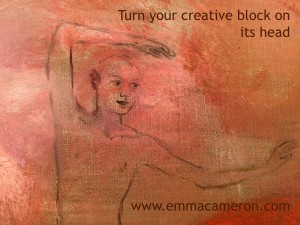I love working with people who are struggling with a creative block. There are lots of ways to work with this problem – here I’m going to share one of them.
I call it ‘turn it on its head’ – it’s about turning a negative into a positive, and through finding new insights, discovering a different way through your block. It’s about turning a passive ‘I can’t’ into an active ‘I choose not to’.
Here’s an example of how it can work.
Say you’re frustrated because you can’t seem to do the final draft of your article. You’ve got so far with things, but somehow you feel immobilised whenever you think about getting the last bits done. ‘I can’t’ you think to yourself – and you immediately get annoyed with yourself for being so hopeless. You don’t understand why, when you’ve got so far already, you can’t just get the thing done!
So, turn it on its head. It feels meaningless and negative; but actually, creative blocks are usually very meaningful. Instead of assuming you’re not doing this thing because you’re just a hopeless case, assume that you’re experiencing a block for some positive (but as yet, unconscious) reason.
Here’s the exercise. Come up with some statements in which you reframe ‘I can’t’ into ‘it’s important for me not to…’
Without pre-thinking it, say out loud 5 to 15 times, ‘it’s important for me not to finish this article because …’ and add a different ending each time (don’t worry if they don’t make sense). Write them down, or better still use a voice recorder and write them down afterwards. Then read them through and notice which ones (if any) feel like they might have a ring of truth to them, even if they sound a bit crazy.
Here’s an example. ‘Ellen’, a journalist, tried this technique and was amazed to find herself saying ‘it’s important for me to not finish this article, because if I finish it and it’s published, my sister will envy me, and I couldn’t bear that’.
When Ellen said this, she realised that somewhere deep inside, this statement felt really true. Not to her normal everyday adult self, who got on pretty well with her sister; but to a part of Ellen that still felt very young, and very vulnerable.
The article was on a subject that was in her sister’s field of work, and Ellen realised that for her, being envied by her sister felt too alarming and painful. When she was able to really think about that and consider all the deeper personal layers of meaning, Ellen got a valuable new perspective on what her creative block was all about.
Ellen found that she was then able to talk with her sister about their relationship in a way that deepened their bond. This freed Ellen up to feel less anxious and controlled by her fear of her sister’s envy. Then Ellen found she could arrive at a point where she was able to finish writing her article successfully and easily, and move on to the next project.
Ellen was able to do this by herself, but it can also be very helpful to do this exercise with a therapist, who can help you identify your blind spots, support you, and help you to integrate what you learn so that it strengthens you. A therapist who uses Coherence Therapy, Gestalt Therapy, Psychoanalytic Psychotherapy or Art Psychotherapy may fit particularly well with this technique.
Give ‘turn it on its head’ a try! It’s not always helpful, but you might just find that it opens something up and frees you to be able to move through your creative block and into something new. Let me know how it goes in the comments below!

